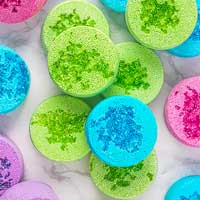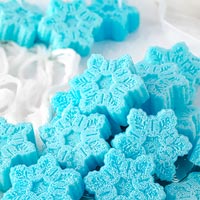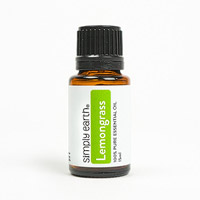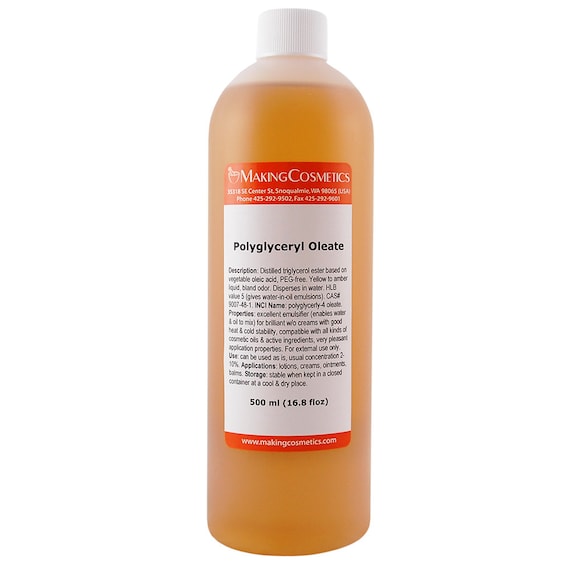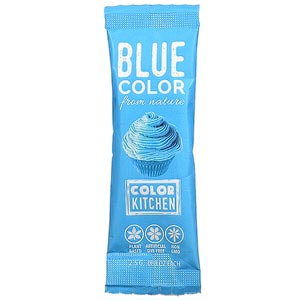Learn how to make allergy shower bombs! This easy shower bombs recipe is made without menthol crystals – instead, it contains antihistamine essential oils for soothing natural allergy relief.
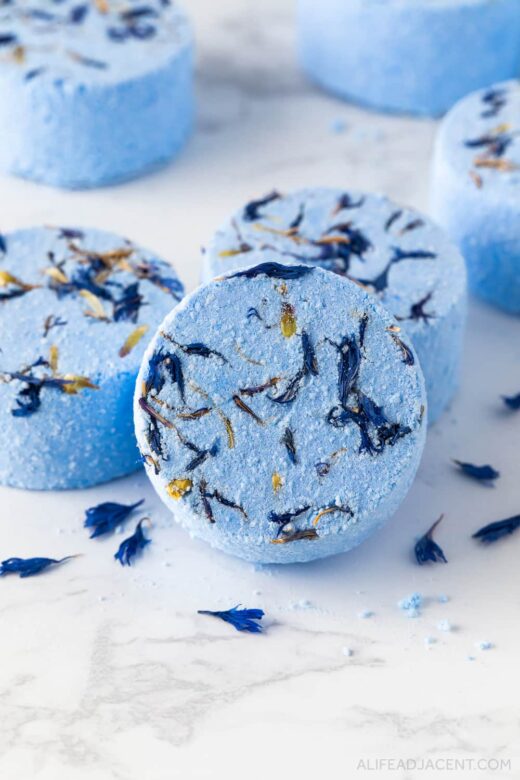
A whiff of strong perfume, a synthetic scented candle, a few minutes spent in a dusty room. Or even worse, stepping outside at the height of hay fever season.
If you have allergies, you understand how easily these scenarios can bring on a barrage of uncomfortable symptoms.
Antihistamines and medicated nasal spray might be the conventional go-tos, but if you’ve found yourself on this blog, you likely seek natural alternatives whenever possible.
And aside from herbal remedies like nettle tea, essential oils can be another useful tool in your natural allergy relief arsenal.
So if you’re in need of relief, read on to learn how to make these easy DIY shower bombs for allergies.
When activated by water, each shower bomb releases a burst of anti-allergy essential oils. So they can help soothe the symptoms of allergies and rhinitis, such as sinus congestion and an itchy nose.
Before the recipe, I’m going to delve into some information on the best essential oils for allergies. But if you’re not interested, you can skip straight to the easy DIY.
For more shower aromatherapy recipes, see also:
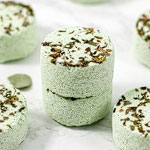
- Why I made these allergy shower bombs
- Why cold and allergy shower bombs aren’t the same
- The best essential oils for allergies
- Blue tansy essential oil for allergies
- How to use blue tansy oil in shower bombs
- Ingredients for allergy shower bombs
- Allergy Shower Bombs Recipe
- How to store homemade shower bombs
- Essential oil blends for allergic rhinitis
Why I made these allergy shower bombs
I have a combination of allergies, fragrance sensitivity, and chronic rhinitis. So I made this shower bombs recipe as someone who truly understands the struggle.
It doesn’t take much to trigger me. Aside from common allergens like dust, dander, and pollen, I’m also sensitive to irritants such as fragrances and even certain essential oils.
A seemingly innocent scented candle burning in someone’s home can cause a full-on episode of blocked sinuses, watery eyes, and a swollen, itchy nose. But smelling perfumed laundry detergent is by far the worst.

Unfortunately, some people just don’t understand this level of sensitivity, and that it’s not just a matter of preference or not “liking” a fragrance.
But I get it. So if this sounds like you too, I hope that these allergy shower bombs can help provide some much-needed relief when you need it. The hot shower steam helps clear a stuffy nose, and the soothing essential oils can help reduce allergy symptoms.
But even if you don’t have allergies, these soothing shower bombs have a multitude of other aromatherapy benefits too. They also make lovely homemade gifts, especially for an allergy sufferer!

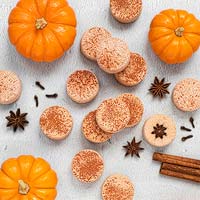
Why cold and allergy shower bombs aren’t the same
There’s a lot of overlap between cold and allergy symptoms. But I’ve tested a lot of DIY shower bomb recipes over the years, and I’ve noticed that certain essential oils work better for different kinds of sinus discomfort.
Eucalyptus and peppermint essential oils are great for colds, so they’re frequently used in decongestant shower melts (along with menthol). But in my experience, these minty, stimulating oils can be even more irritating to a red, runny, itchy nose caused by allergies or rhinitis.
So I think shower bombs for allergies and colds are 2 different things. Because allergies aren’t just about sinus congestion, but increased levels of histamine that can lead to full-body discomfort and irritation.
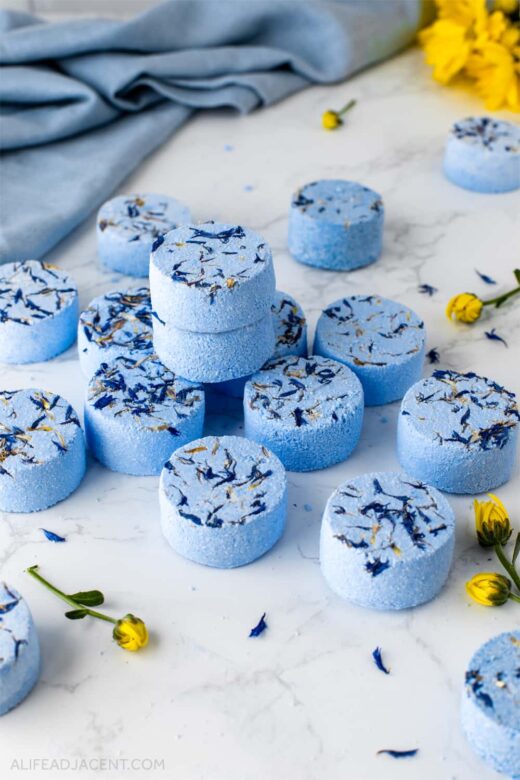
Allergy sufferers know all too well that allergy attacks can cause an overall feeling of malaise or “itchiness”. This can also extend itself to your skin and eyes, and in some cases, can even manifest as muscle pain.
So when you’re already feeling inflamed and sensitive, it makes sense that menthol or certain essential oils could make your itchy sinuses feel even worse. That’s why I also made this shower bombs recipe without menthol crystals.
But again, this is just my own personal experience. Some people may find menthol, eucalyptus, and peppermint oil to be extremely soothing for their allergy symptoms. And in that case, you might prefer these sinus shower melts instead.
But if minty oils don’t work for your allergies either, there are some other essential oils that might.
The best essential oils for allergies
Aromatherapy has long been used to help treat a variety of conditions, including allergies.
Studies indicate that certain essential oils have anti-histamine and anti-allergy properties. When inhaled, these oils can help soothe a variety of allergy and rhinitis symptoms, including rinorrhea, fatigue, and a stuffy, itchy nose1.
So, if typical decongestant oils such as peppermint don’t always work for allergies, what are the best essential oils for allergy shower melts?

Some of the best antihistamine essential oils include:
- Blue tansy2
- Blue yarrow3
- Chamomile2,4
- Eucalyptus2,5
- Frankincense2
- Helichrysum2
- Lemon6
- Lemongrass6
- Ravensara2
- Rosemary2
- Sandalwood2,6
- Vetiver2
In a study of 20 essential oils, lemongrass oil exerted the strongest anti-allergy effects6. It was even more effective than chamomile oil, which is also frequently used for allergies.
And in another study, a blend of ravensara, frankincense and sandalwood essential oils helped decrease some of the symptoms and discomfort associated with allergic rhinitis1.
Of course, this isn’t an exhaustive list, just some of the oils I came across while researching the best essential oils for allergic rhinitis. You can also find more allergy essential oil blends in the section below the DIY.

I chose a soothing blend of blue tansy and lemongrass essential oil for this allergy shower bomb recipe.
Aside from the evidence that it works, I also find lemongrass oil’s zesty, citrusy aroma feels particularly refreshing and soothing during a flare-up of allergy symptoms.
But the real star of these sinus and allergy shower melts is soothing blue tansy essential oil. It has a sweet, fresh, fruity aroma with herbaceous overtones, and it complements lemongrass oil beautifully.
However, blue tansy does a lot more than simply smell nice – the same oil that works wonders for calming irritated skin can also help soothe pesky allergy symptoms.

Blue tansy essential oil for allergies
Beautiful blue tansy oil was an obvious choice for allergy relief shower bombs.
One of the most calming essential oils, blue tansy oil has soothing, antihistamine, and anti-allergy properties that make it one of the best essential oils to diffuse for allergy relief.
According to herbalist Peter Holmes, blue tansy has been used medicinally for decades, despite lacking in formal research. In traditional Chinese medicine, it’s used as a congestion relief aid2. And French herbal practitioners have long been using blue tansy oil to help treat a variety of allergic conditions2.
But aside from its anti-allergy effects, blue tansy oil is also very emotionally soothing. It’s said to help calm feelings of anxiety, panic, stress, and tension2.
So if you’re feeling stressed, you can also use one of these soothing shower steamers for calming aromatherapy.

Another helpful use for blue tansy oil: when my allergy symptoms get particularly bad, I sometimes use the oil around my nostrils (properly diluted). It helps soothe my sinuses and calm skin irritation caused by constant nose-blowing.
But this isn’t medical advice, so you should ask your health practitioner whether this is safe for you.
How to use blue tansy oil in shower bombs
Blue oils like blue tansy are precious, so they tend to be a little bit more expensive than common lavender or peppermint.
They won’t break the bank like pure rose oil. But I like to save blue tansy oil for skincare products or for emergency aromatherapy use, like these soothing shower bombs.
So to help make every drop count, you can also add an optional antioxidant and emulsifier to help protect the essential oils.
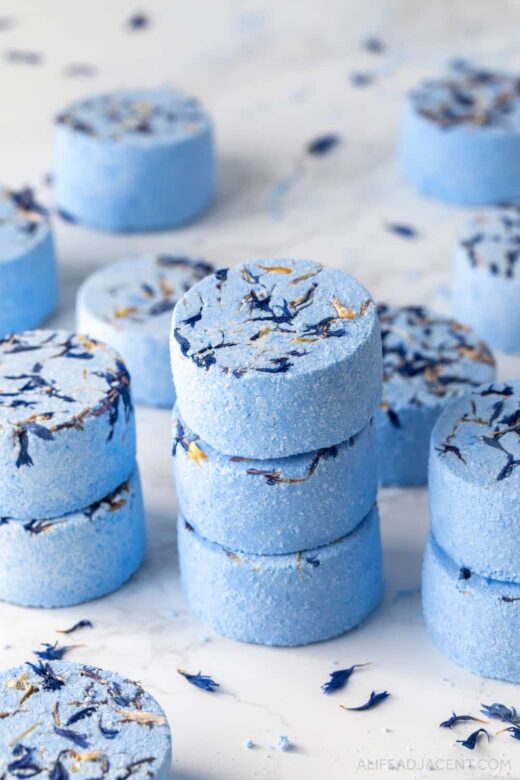
If you don’t have blue tansy oil, you can also substitute another blue oil such as blue yarrow, Roman chamomile, or German chamomile essential oil. (I’ve also included some more allergy blends below the recipe.)
Alternatively, you can create your own shower bomb essential oil blend by combining any of the anti-allergy oils mentioned in this post. After all, the essential oils that work best for your allergies are unique to you.
One more thing to note: essential oils such as blue tansy are not allergy cures. These shower bombs help provide soothing relief, but they’re not going to take your symptoms from a level 10 to 0 within minutes.
Essential oils are just another useful tool, so shower soothers are a good adjunct to your other natural allergy remedies like stinging nettle or quercetin (and a good saline nasal spray!). And as always, please follow your doctor’s advice on what’s best for you.
Ingredients for allergy shower bombs
For this recipe, you’ll need the typical shower bomb ingredients:
- Baking soda
- Citric acid
- Corn starch or kaolin clay
- Allergy relief essential oil blend
- Alcohol to moisten mixture
As we all know, baking soda and citric acid create the reaction that puts the “fizzy” in shower fizzies. The fizzing helps shoot the essential oils into the air for fast-acting, soothing aromatherapy.
Clay or corn starch act as binders, and they also help homemade shower bombs last longer. You can use either one, but starch absorbs more moisture, so you might prefer to use clay if you live in a humid climate.
As for coloring, blue tansy oil is a very vibrant, soothing blue, so it adds a hint of color on it own. But you can also use a small amount of blue mica or blue spirulina powder for a more vibrant color.

Clay is another effective way to color shower steamers, so you can also replace the white clay with French or Cambrian blue clay. We also used lavender clay in our lavender shower melt recipe for a pale purple color.
Finally, if desired, you can decorate your DIY shower bombs with a sprinkling of dried flower petals or botanicals.
I used blue cornflower petals to match the blue tansy oil. Whole calendula flowers would be another pretty choice to emulate the blue tansy flower (which is actually yellow).
Optional shower bombs ingredients
One issue with making DIY shower bombs is that you inevitably lose some essential oils during the drying process.
Essential oils are extremely volatile, and they evaporate quickly. And when exposed to air, some of their more delicate components degrade and lose their efficacy.
Blue tansy oil is no exception, as it’s very delicate, and will quickly oxidize and turn green if not stored properly. And because its aromatherapy benefits are so crucial for this recipe, I really wanted to prevent this!
There are 2 ingredients that can help offset essential oil evaporation in shower bombs:
Rosemary CO2 extract is an antioxidant, so it helps preserve the essential oils, while the liquid emulsifier helps keep the oils suspended in the tablets
Do shower bombs need an emulsifier?
Emulsifiers aren’t technically necessary for shower bombs, because unlike bath bombs, they don’t come into direct contact with your skin.
But there’s still a benefit to using them, which is why emulsifiers are commonly used in store-bought steamers and handmade shower bombs on Etsy.
Emulsifiers help disperse essential oils uniformly in the shower bombs formula. They also act as a binder to hold the mixture together, ensuring shower melts that don’t crumble.
Plus, emulsifiers slow evaporation. So they help stop your essential oils from evaporating before you’ve even had a chance to enjoy their soothing aromatherapy! As a result, adding an emulsifier will help make your shower melts smell stronger for longer.
Another added benefit: using an emulsifier slows the fizzing reaction, so this is another way to make shower bombs last longer.
Emulsifier for allergy shower melts
Polysorbate 80 is the most common emulsifier for bath and body products, but you don’t need polysorbate 80 to make shower steamers.
I prefer natural polysorbate alternatives such as CreamMaker FLUID, polyglyceryl oleate or sorbitan oleate. We’ve used the latter two in DIY bath bombs for years, and they work just as well in shower bombs too.
You can use any of the above natural liquid emulsifiers interchangeably – I tested them all.
But I understand emulsifiers might not be accessible to everyone, and not everyone wants to go to the trouble of buying yet another ingredient.
Luckily, castor oil makes an economical alternative, and also helps preserve the essential oils in your shower bombs. Read more about using castor oil in our detailed guide for how to make shower steamers.

Allergy Shower Bombs Recipe
1/2 cup baking soda
1/4 cup citric acid
2 tbsp kaolin clay or corn starch
1/2 tsp blue spirulina or 1/4 tsp blue mica powder (optional)
1/2 tsp / 2.5ml natural liquid emulsifier or castor oil (see notes)
30 drops blue tansy essential oil
30 drops lemongrass essential oil
3 drops rosemary CO2 extract (optional)
Dried blue cornflower petals (optional)
Equipment
Silicone shower bomb mold
Small glass lab beaker
Non-metallic mixing bowl
Vodka or alcohol to moisten mixture
Small spoon or beaker for alcohol
Sieve for uniform texture
Wooden spoon for mixing
Nitrile gloves to protect hands
Shower steamer dish (optional)
How to make DIY shower bombs for allergies
- Prepare your mold. Before you begin, sprinkle your blue cornflower petals or other decorative flowers on the bottom of the shower bomb mold.
- Mix dry ingredients. In a large non-metallic mixing bowl, sift baking soda, citric acid, corn starch (or clay) and your blue colorant (mica or spirulina). Stir gently with a wooden spoon to combine.

- Mix essential oils with emulsifier. In a tiny lab beaker or small container, combine the emulsifier (or castor oil), rosemary extract, and allergy essential oil blend. Mix gently with a tiny whisk or stirring rod to combine.
- Add mixture to shower bombs. Pour the essential oil mixture evenly over your dry shower bomb ingredients. Use a wooden spoon to knead the mixture until everything is evenly incorporated.
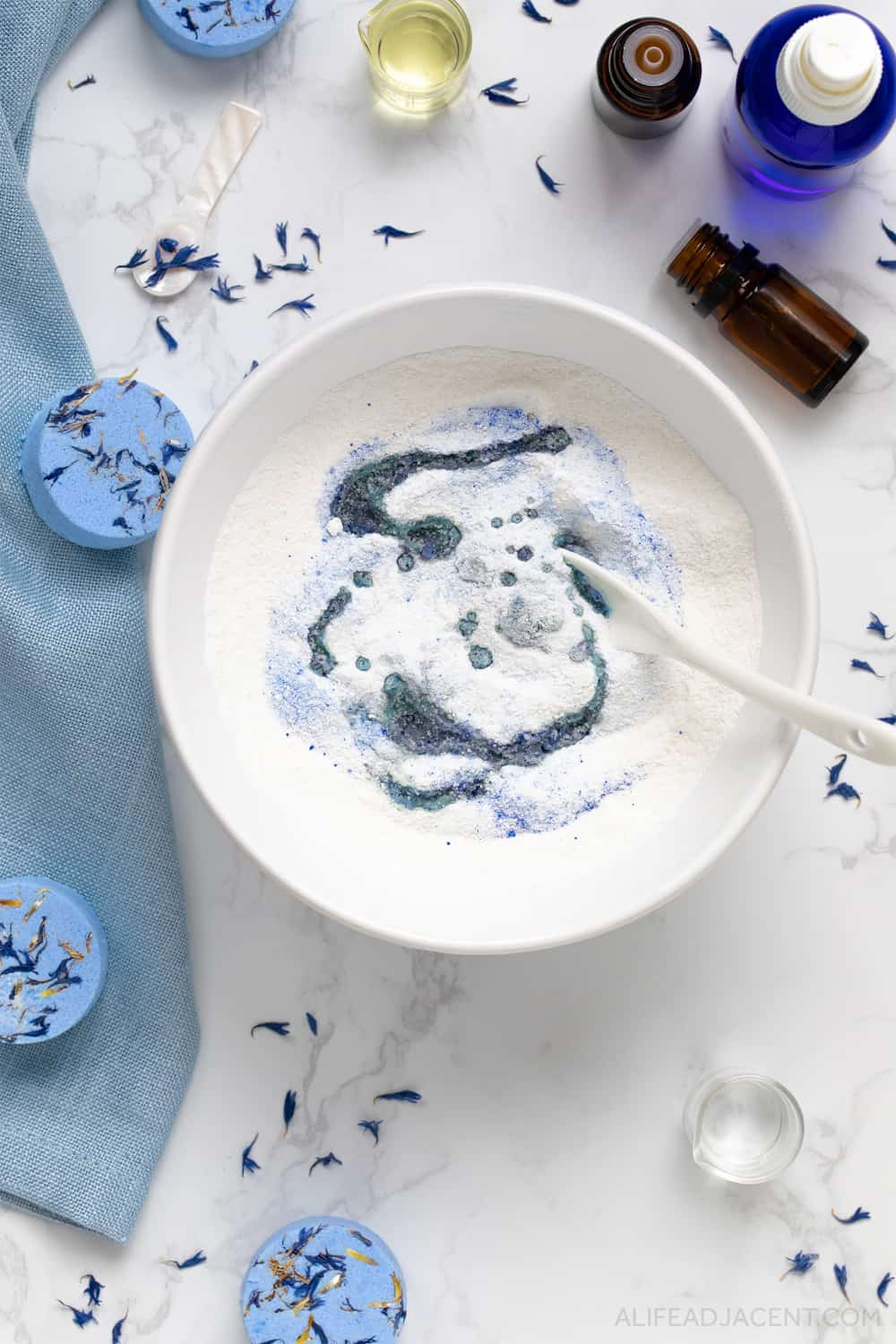
- Add liquid. Put on your nitrile gloves and prepare to work quickly, because once you moisten the dry mixture, it will begin to fizz immediately. Add a small amount of vodka or alcohol to the bowl and knead quickly with your hands to incorporate.
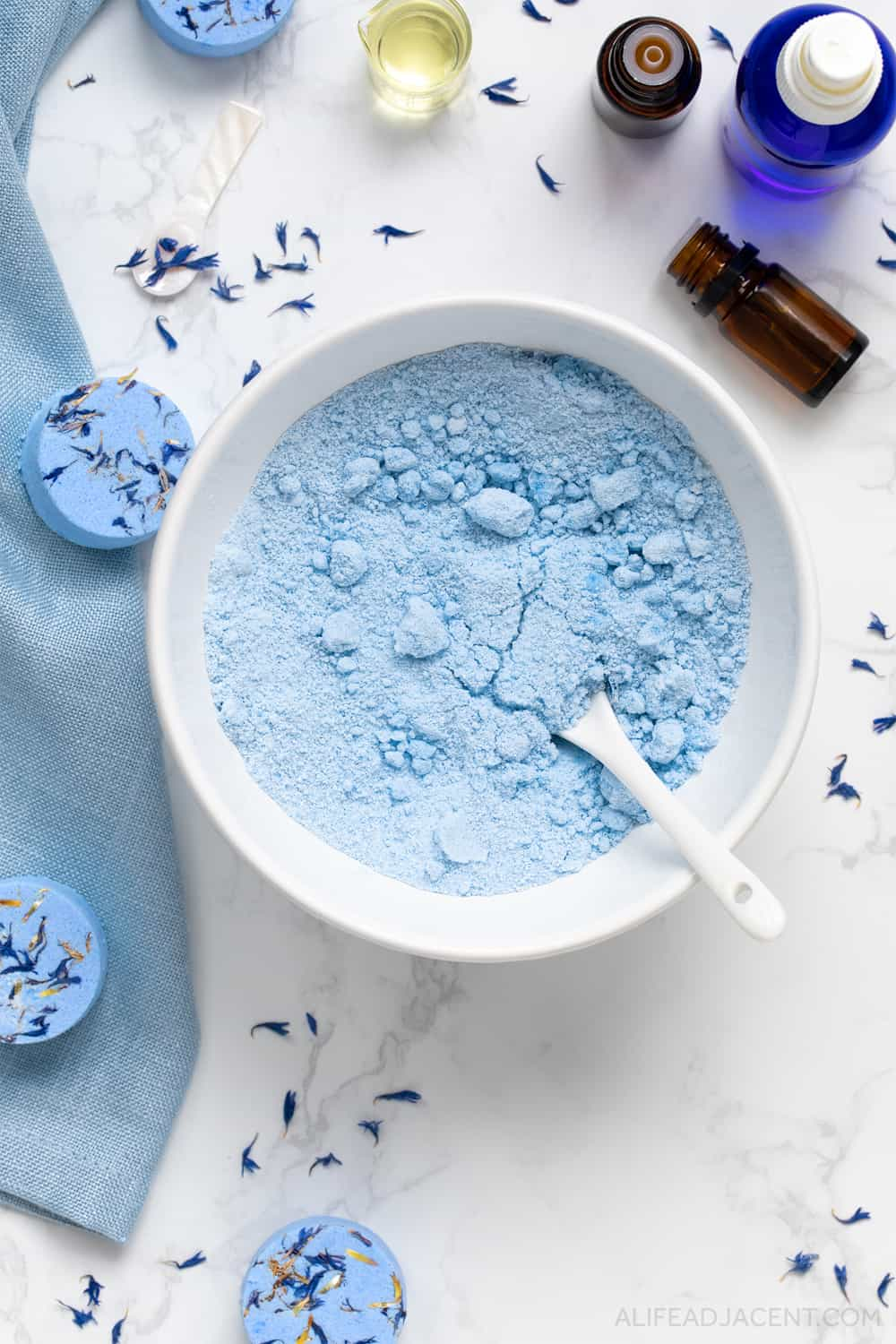
- Check shower melts texture. Squeeze a handful of shower bomb mixture to see if it sticks together. It should be just moist enough to hold it shape, like damp sand. But if it’s dry or crumbly, keep adding a bit more liquid until you achieve the right consistency. Just don’t add too much – it shouldn’t feel wet or doughy, or your shower fizzies will fizz and expand in the mold.
- Mold shower tablets. Firmly pack the mixture into your mold, and press down with a spoon or your fingers to ensure your tablets have a nice, uniform shape. Smooth out the tops as you go.
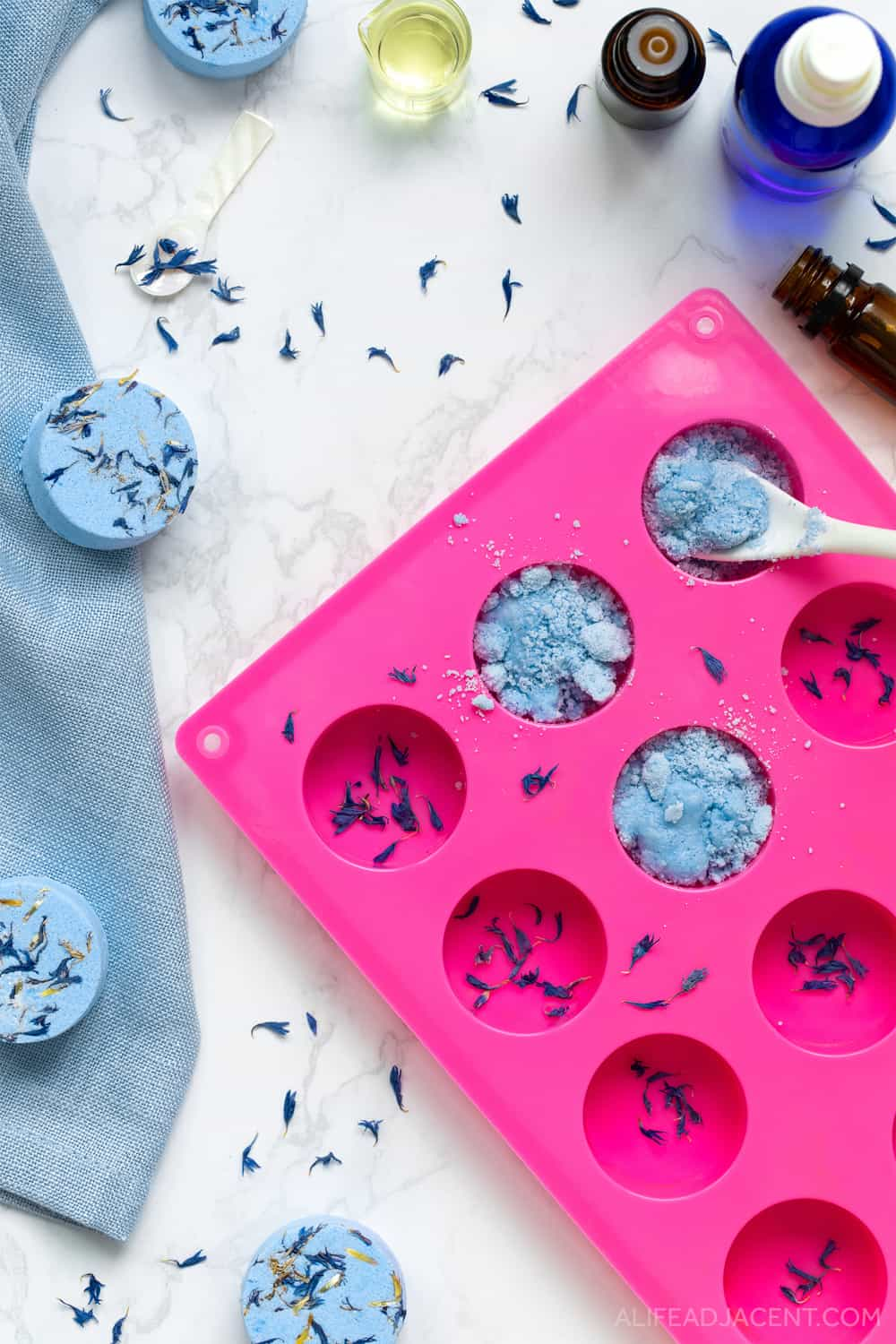
- Leave to dry. Leave your shower steamers to dry overnight in an area where they won’t be disturbed.
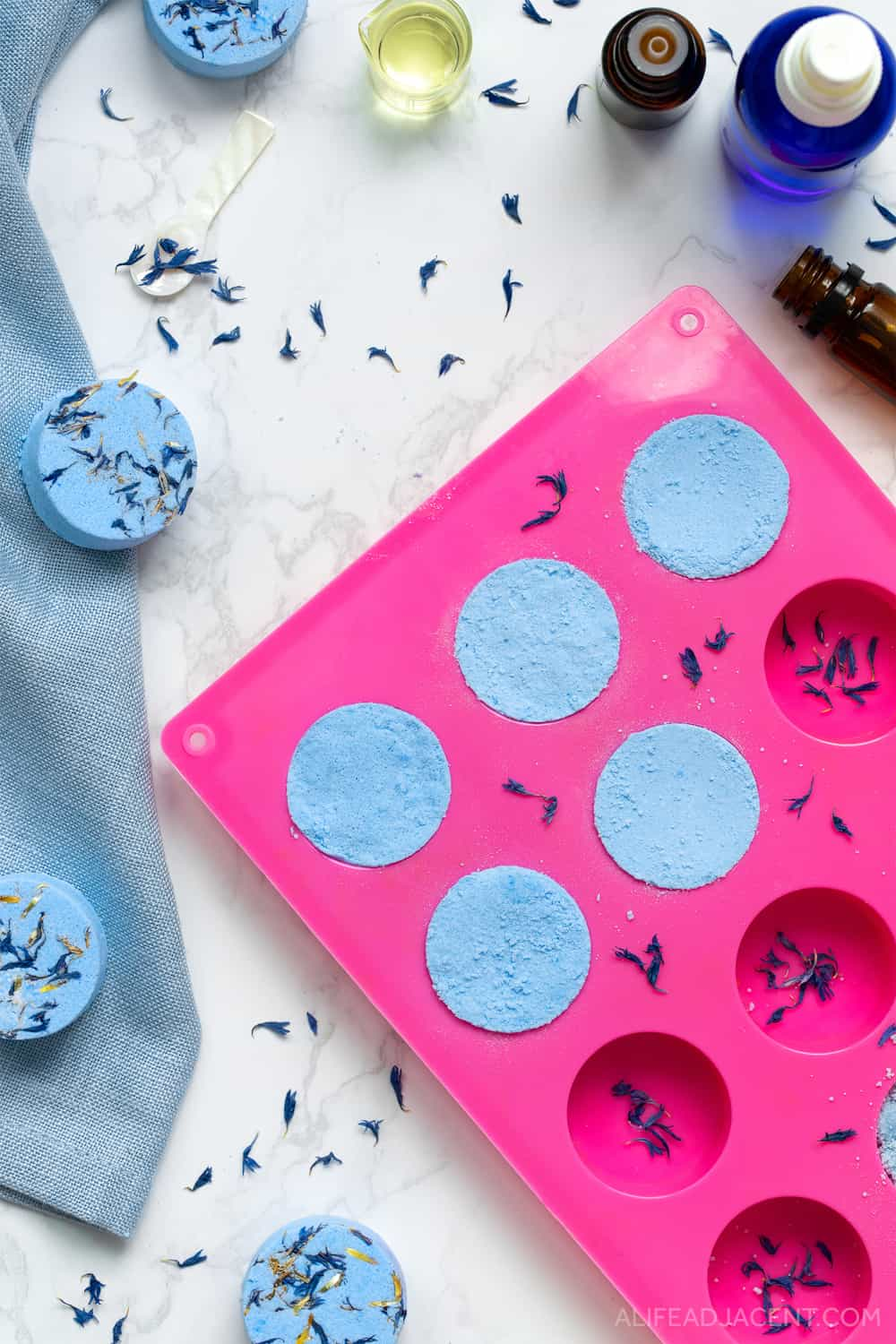
- Remove from mold. The next day, carefully peel back the silicone and remove each tablet from the mold. If they are still slightly tacky or sticky, leave them out for a little while longer until they are hard to the touch.
- Finished! Your DIY shower bombs are ready to use whenever allergies strike or when you’re in need of soothing aromatherapy. To use, place one tablet in the shower, away from the direct stream. Choose an area where it will get wet enough to fizz, but not so soaked that it will wash away, such as at your feet or in its own shower steamer dish.
Tips for making shower bombs for allergy relief
- This recipe makes 6 soothing shower tablets, and each contains 10 drops of essential oils. You can also double the recipe if you’d like to make a larger batch.
- You can use any of the following natural liquid emulsifiers for this recipe: polyglyceryl oleate, sorbitan oleate, CreamMaker FLUID, or CreamMaker ANIO. Alternatively, you can also use castor oil.
- To make the shower bombs stronger, simply boost them with a few more drops of essential oils before use.
- Clay is very absorbent. So if you’re making your shower bombs with clay, you can also use water or witch hazel to moisten your mixture instead of alcohol.
- For a natural blue color, you can also replace the white clay in this recipe with blue clay, such as Cambrian or French blue clay.
- For best results and the most potent anti-allergy effects, use your shower bombs within 3 months.
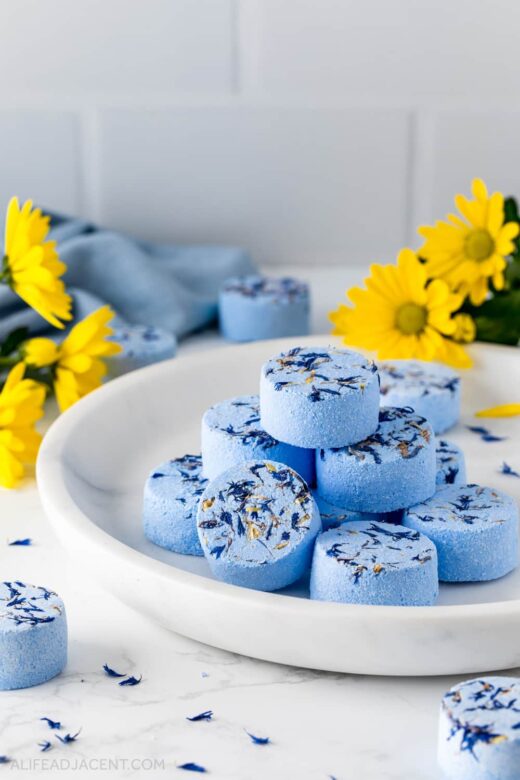
How to store homemade shower bombs
DIY shower bombs should always be stored in an airtight container in a cool, dark place. This is very important, as both light and air exposure will rapidly degrade the fragile essential oils.
And unless you use a closed container, the essential oils may evaporate before you’ve had a chance to experience any allergy relief!
Even with proper storage conditions, you should still aim to use your shower melts within 3 months for the most potent aromatherapy. I know – unfortunately, this isn’t exactly convenient if you’d like to keep them on hand for when allergy symptoms strike!
But once you get the hang of making shower bombs at home, it doesn’t take long to whip up a fresh batch. It’s a good idea to plan ahead and make a some right before allergy season is set to begin.
Essential oil blends for allergic rhinitis
Aside from blue tansy and lemongrass, here are some other essential oil blends that may be useful for alleviating allergy symptoms:
- Blue tansy + Helichrysum2
- Rosemary + Ravensara2
- German Chamomile + Blue Tansy2
- Blue Tansy + Cedarwood
- Lemongrass + Vetiver
- Ravensara + Frankincense1
- Lemon + Eucalyptus

Allergy Relief Shower Bombs (DIY Shower Steamers for Allergies)
Learn how to make DIY shower steamers for allergies! This easy shower melts recipe is made with the best antihistamine essential oils for natural allergy relief. Make these allergy shower bombs to help soothe rhinitis and sinus issues like congestion, sneezing, and itchy nose.
Materials
- 1/2 cup baking soda
- 1/4 cup citric acid
- 2 tbsp kaolin clay or corn starch
- 1/2 tsp blue spirulina or 1/4 tsp blue mica powder (optional)
- 1/2 tsp / 2.5ml natural liquid emulsifier (optional, see notes)
- 30 drops blue tansy essential oil
- 30 drops lemongrass essential oil
- 3 drops rosemary CO2 extract (optional)
- Dried blue cornflower petals (optional)
Tools
- Silicone shower bomb mold
- Small glass lab beaker
- Non-metallic mixing bowl
- Vodka or alcohol to moisten mixture
- Small spoon or beaker for alcohol
- Sieve for uniform texture
- Wooden spoon for mixing
- Nitrile gloves to protect hands
Instructions
- Prepare your mold. Before you begin, sprinkle your blue cornflower petals or other decorative flowers on the bottom of the shower bomb mold.
- Mix dry ingredients. In a large non-metallic mixing bowl, sift baking soda, citric acid, corn starch (or clay) and your blue colorant (mica or spirulina). Stir gently with a wooden spoon to combine.

- Mix essential oils with emulsifier. In a tiny lab beaker or small container, combine the emulsifier, rosemary extract, and allergy essential oil blend. Mix gently with a tiny whisk or stirring rod to combine.
- Add mixture to shower bombs. Pour the essential oil mixture evenly over your dry shower bomb ingredients. Use a wooden spoon to knead the mixture until everything is evenly incorporated.
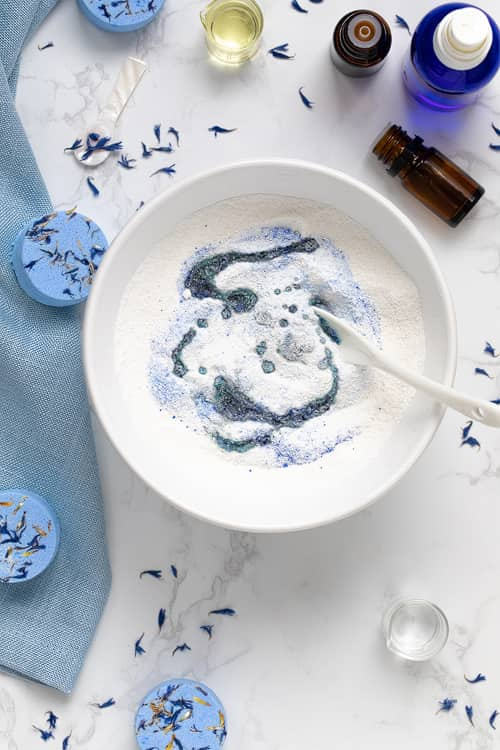
- Add liquid to moisten. Put on your nitrile gloves and prepare to work quickly, because once you moisten the dry mixture, it will begin to fizz immediately. Add a small amount of vodka or alcohol to the bowl and knead quickly with your hands to incorporate.
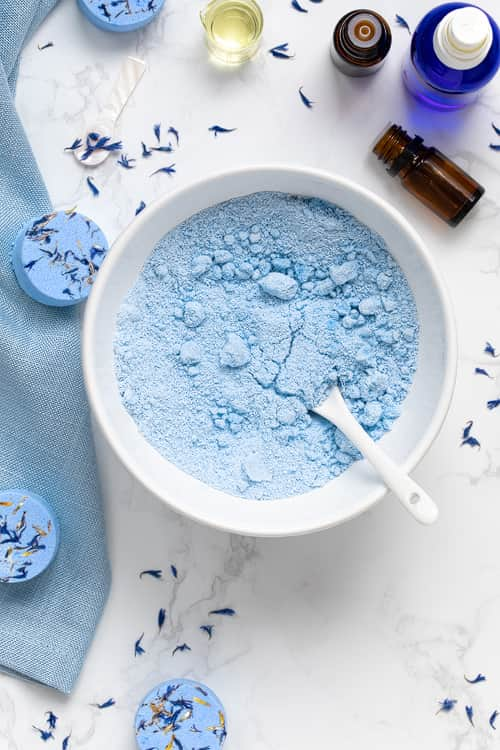
- Check shower melts texture. Squeeze a handful of shower bomb mixture to see if it sticks together. It should be just moist enough to hold it shape, like damp sand. But if it's dry or crumbly, keep adding a bit more liquid until you achieve the right consistency. Just don't add too much – it shouldn't feel wet or doughy, or your shower fizzies will fizz and expand in the mold.
- Mold shower tablets. Firmly pack the mixture into your mold, and press down with a spoon or your fingers to ensure your tablets have a nice, uniform shape. Smooth out the tops as you go.

- Leave to dry. Leave your shower steamers to dry overnight in an area where they won't be disturbed.
- Remove from mold. The next day, carefully peel back the silicone and remove each tablet from the mold. If they are still slightly tacky or sticky, leave them out for a little while longer until they are hard to the touch.

- Finished! Your DIY shower bombs are ready to use whenever allergies strike or when you're in need of soothing aromatherapy. To use, place one tablet in the shower, away from the direct stream. Choose an area where it will get wet enough to fizz, but not so soaked that it will wash away, such as at your feet or in its own shower steamer dish.
Notes
Tips for making allergy relief shower bombs
- This recipe makes 6 soothing shower tablets, and each contains 10 drops of essential oils. You can also double the recipe if you'd like to make a larger batch.
- You can use any of the following natural liquid emulsifiers for this recipe: polyglyceryl oleate, sorbitan oleate, CreamMaker FLUID, or CreamMaker ANIO.
- If making shower tablets without fragrance, add 5 drops each blue tansy and lemongrass oil to each tablet right before use.
- To make the shower steamers stronger, simply boost them with a few more drops of essential oils before use.
- If using clay, I've found that you can get away with using a small amount of witch hazel or water to moisten the mixture. But if you're making shower bombs with corn starch, you should use alcohol (such as vodka) instead. This is because corn starch tends to get wet and doughy when mixed with water. But alcohol evaporates faster than water, which helps avoid this issue and create a nice, hard shower tablet.
- For a natural blue color, you can also replace the white clay in this recipe with blue clay, such as Cambrian or French blue clay.
- For best results and the most potent anti-allergy effects, use your shower bombs within 3 months.
Recommended Products
As an Amazon Associate and member of other affiliate programs, we earn from qualifying purchases.
More shower bomb recipe ideas
If you enjoyed making these shower steamers for allergies, you might also enjoy these recipes:
- 7 DIY Shower Steamers Recipes
- 4 Aromatherapy Shower Bomb Recipes
- Shower Melts for Colds & Congestion
- Pumpkin Spice Shower Bath Bombs
- Lavender Shower Steamer Recipe
For more aromatherapy recipes, follow us on Pinterest, Instagram, YouTube, Facebook, TikTok, and Twitter.
Pin it for later


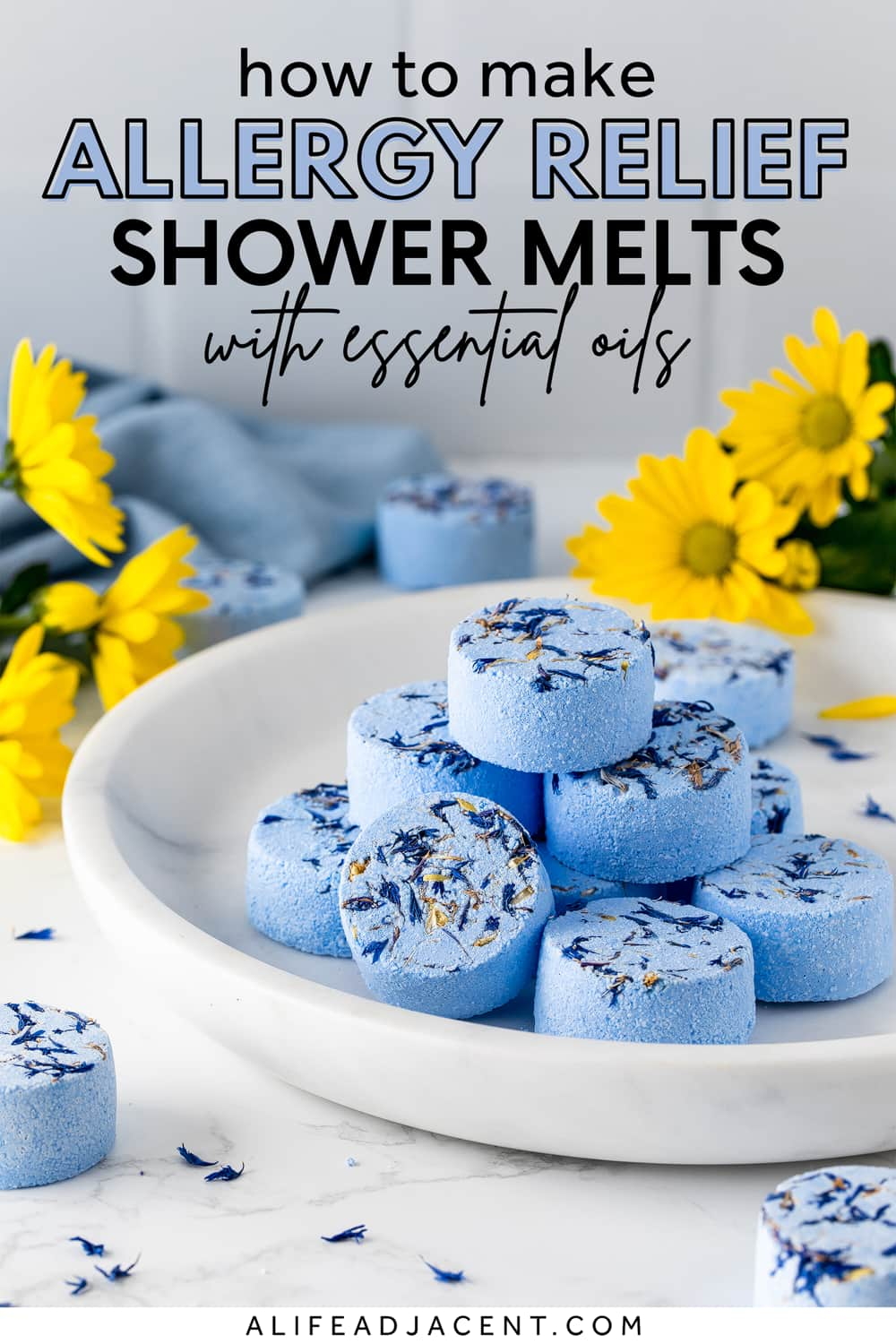
- Choi, Seo Yeon, and Kyungsook Park. “Effect of Inhalation of Aromatherapy Oil on Patients with Perennial Allergic Rhinitis: A Randomized Controlled Trial.” Evidence-based complementary and alternative medicine : eCAM vol. 2016 (2016): 7896081. doi:10.1155/2016/7896081
- Holmes, Peter, et al. Aromatica: A Clinical Guide to Essential Oil Therapeutics. Singing Dragon, 2016.
- Clarke, Sue, and Sue Clarke. Essential Chemistry for Aromatherapy. Elsevier Health Sciences, 2009.
- Lee, Soon-Hee et al. “Effect of German chamomile oil application on alleviating atopic dermatitis-like immune alterations in mice.” Journal of veterinary science vol. 11,1 (2010): 35-41. doi:10.4142/jvs.2010.11.1.35
- Nakamura, T., Yoshida, N., Yamanoi, Y. et al. Eucalyptus oil reduces allergic reactions and suppresses mast cell degranulation by downregulating IgE-FcεRI signalling. Sci Rep 10, 20940 (2020). https://doi.org/10.1038/s41598-020-77039-5
- Mitoshi, M., Kuriyama, I., Nakayama, H., Miyazato, H., Sugimoto, K., Kobayashi, Y., Jippo, T., Kuramochi, K., Yoshida, H., Mizushina, Y.”Suppression of allergic and inflammatory responses by essential oils derived from herbal plants and citrus fruits”. International Journal of Molecular Medicine 33.6 (2014): 1643-1651.

